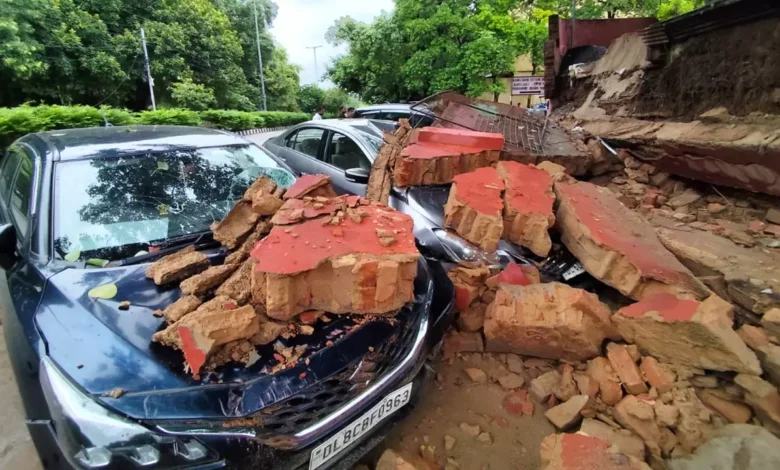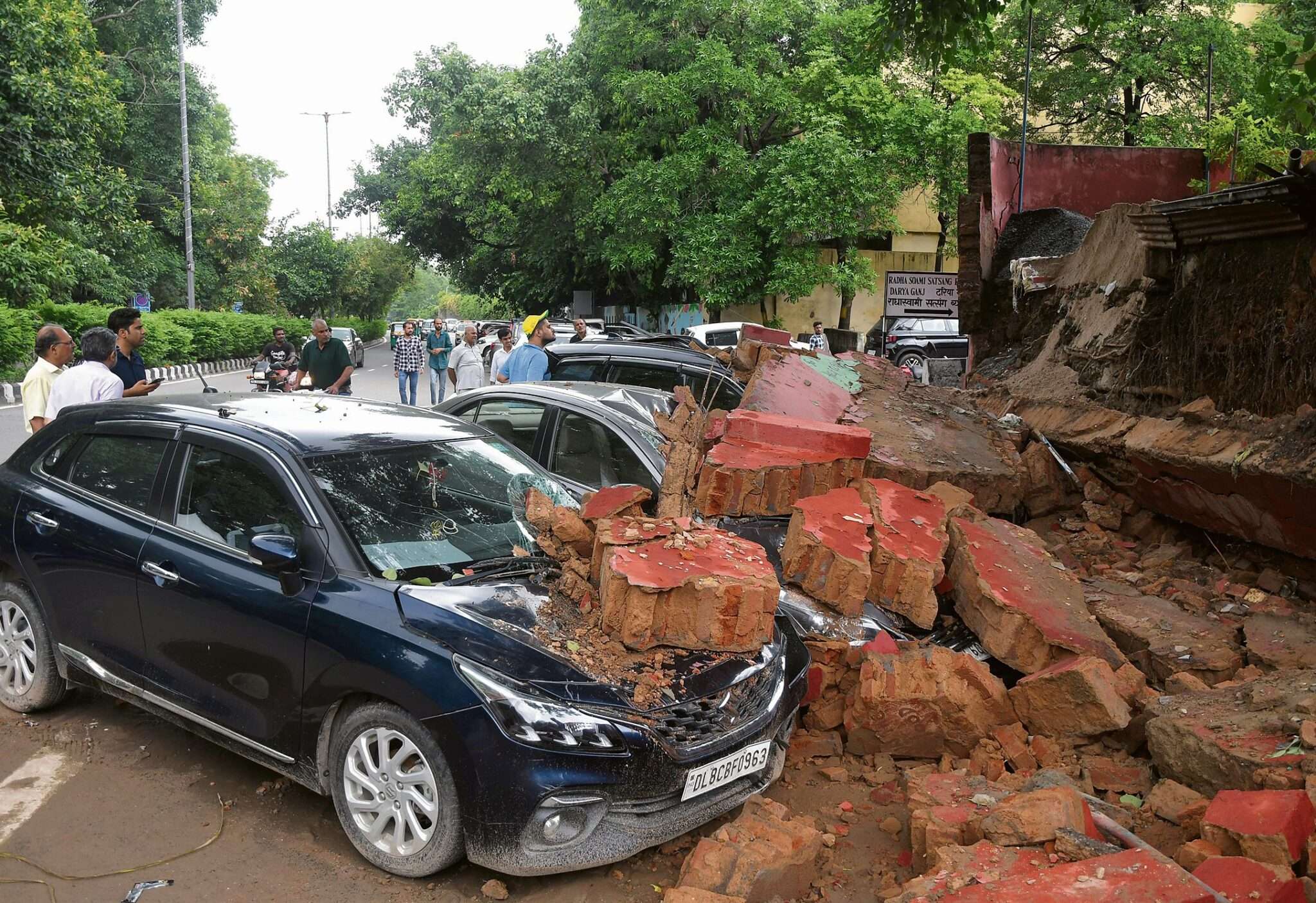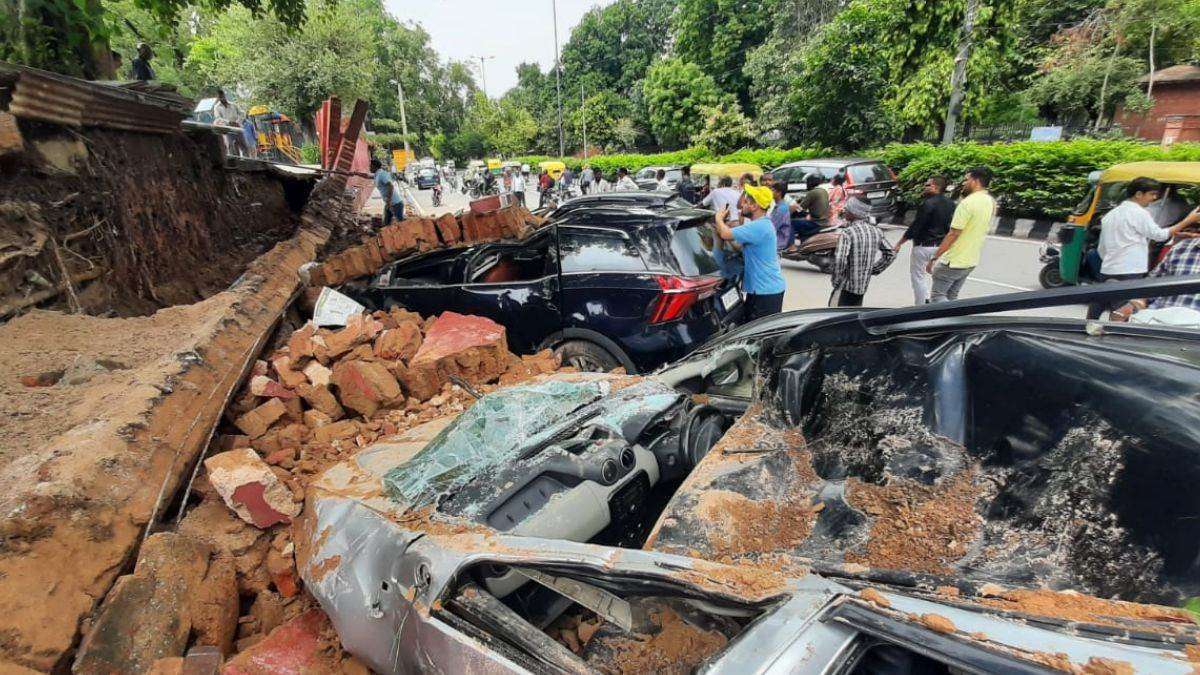Chaos Erupts as Heavy Rains Trigger School Wall Collapse in Delhi’s Daryaganj, Exposes Delhi’s Infrastructure Crisis!
The shocking incident of the collapse of a part of the wall of a private school due to heavy rains, leaving several damaged vehicles. Fortunately, there were no reports of any casualty, but the incident has once again brought to the fore the shocking state of infrastructure, especially in the city's educational institutions, all across the national capital.

In a surprising incident, a wall of a private school in Delhi’s Daryaganj area collapsed due to the heavy rainfall that has struck the capital city. The falling wall caused massive damage to several parked vehicles and left residents shaken, with authorities rushing to respond to the crisis.
Vehicles damaged as Wall Comes Crashing Down
A car which was parked just outside the school compound was almost completely crushed, leaving a sheer force of the impact. Other vehicles in the area also suffered varying degrees of damage, where dents, scratches, and shattered windows characterised the scene.
“It was a frightening experience. We heard a loud crash and came running out to see what had happened. The school wall had collapsed right on top of the parked cars. It’s a miracle no one was hurt,” a local resident said.
Heavy Rains Trigger Chaos Across Delhi
The Daryaganj incident is just one of the many calamities that have struck Delhi in the wake of incessant rainfall. There has been massive waterlogging in several parts of the city, with key stretches like the Outer Ring Road and Mahatma Gandhi Marg seeing severe flooding and traffic disruptions.
A house collapse has also been reported in North Delhi’s Sabzi Mandi area, though there are no confirmed casualties as of now. The Daryaganj school wall collapse is the newest in a line of incidents related to rain that has left the city reeling.
In the deteriorating situation, a red alert for Delhi was issued by the India Meteorological Department, warning of more heavy showers in the coming days. As a precautionary measure, the Delhi government announced closure of schools.
Many residents have expressed their anxiety over the lack of preparedness and infrastructure for handling such extreme weather events as the city grapples with the aftermath of the deluge. Questions have been raised regarding quality in the construction and maintenance of public buildings and roads, with the Daryaganj school wall collapse an indicator of a much larger malaise.
“This is not the first time that Delhi has witnessed such a disaster due to heavy rainfall. It has been a yearly affair when the same saga of waterlogging, damage to infrastructure, and loss of life occurs. The question everybody asks is when the authorities are going to realise their mistake and do something tangible.”- said Neha, a concerned citizen.
As the city gets ready to face more rainfall in the coming days, greater challenges lie with the government and civic agencies to ensure adequate measures are in place that would not only help protect the lives of people but also their property. The incident at Daryaganj acts as a reminder that Delhi’s infrastructure needs to be made resilient to counter the odds of extreme weather conditions by devising a workable plan.
India drowns every year. India’s cities turn into Venice in every monsoon. Roads turn into rivers. Fishes swim on railway tracks. And it’s not clear whether to buy a car or a boat in such weather. Recently, there was a landslide in Kerala. Bihar and Assam flood every year. In Delhi, the IAS coaching centre lost the lives of talented children.

Last month, Kishore Singh Kushwah, who is a resident of Karol Bagh, filed 3 complaints against MCD, saying that the coaching institutes are doing illegal work in their basements.’ These incidents are a slap to Indian citizens because it happened a few days after the announcement of the budget and a few days before the tax submission deadline.
The residents of Delhi have been slapped, because their MP blamed the state government, who blamed the MCD, whose officers are appointed by the Lieutenant Governor, who is appointed by the central government. And this story is not just about Delhi, it’s about every city in the country.
Whether it’s Delhi, Mumbai, or Bengaluru, the urban infrastructure is hollow from within. The government does give some infrastructures a No Objection Certificate but on limited grounds.
Delhi has 3740 km of drains. But how many authorities manage these drains? Eight.
The Public Works Department manages the drains around Ring Road. The Municipal Corporation of Delhi manages the drains that are less than 60 feet. That’s why residents of Delhi says, the chief Minister is in jail, which is why the administration is on autopilot. The Prime Minister is busy with ‘Mann Ki Baat.’ The Mayor is celebrating the rain. And the LG keeps fighting with the elected government.
Whether it’s Delhi, Bengaluru, or Mumbai, the cities are in the ICU. And the problem is not money, it’s accountability. When there are municipal and state elections in Delhi, why is an unelected LG governing?
What’s the logic behind this?
A clear responsibility and accountability must be given to local governments.
On 28th June, 2024, the roof of Delhi Airport’s Terminal 1 fell. On 27th June, 2024, the roof of Jabalpur’s recently inaugurated airport collapsed. On 1st July, two people were killed in Mathura when a 250,000 litre water tank collapsed.
According to official data, between 2018 and 2022, 8,500 people have died because of the collapse of public infrastructure. This incident is far from isolated. In recent years, the capital has witnessed a spate of similar collapses, involving both residential and commercial buildings. Experts attribute this to a combination of factors, including substandard construction, disregard for building codes, and the increasing intensity of monsoon rains.

This pressure to meet deadlines and maximise profits, very often, forces a compromise on the quality of construction. Builders often cut corners by using poor-quality materials and an unskilled workforce so work is completed quickly. What is more worrisome is that laxity in enforcing building regulations by the authorities has let many structurally weak buildings stand tall.
This has also caused so much strain on the city’s infrastructure. With the surging demand for housing and commercial spaces, the developers rush to meet the market’s needs at the expense of safety. The pace of urbanisation was so fast that it outstripped the capacity of the regulatory bodies in ensuring adherence to building standards.
The blame should directly fall on the school management for the collapsed school wall. It is their responsibility to ensure that the students and the staff are safe. That would involve routine maintenance checks, in accordance with building codes and emergency preparedness plans.
Most of the responsibility falls to the local bodies, which are in charge of permits for building, inspections, and disaster management. The laxity in implementation or corruption at the level of approval may lead to the choice of poor construction. Construction quality itself is a major factor. Inferior materials and/or lousy workmanship may further compromise the intrinsic structure of a building.
The agencies responsible for building standards and enforcement are themselves to blame. Had they identified and corrected these problems at an earlier stage, such incidents would not have taken place. The school wall collapse is a shocking reminder of the need for radical changes in the sector. More stringent building codes with strong enforcement will prevent such disasters.
Besides, there has to be independent auditing of existing structures to establish their safety. Insecure buildings have to be identified and retrofitting has to be done with a view to strengthening them against extreme weather conditions.
The government also has to invest in building resilient urban infrastructure that can cope with the vagaries of climate change. It has to do with improving the drainage system, building retention ponds and green spaces to absorb rainwater.
Above all, the safety of the citizenry must be paramount. The authorities should act decisively to address this infrastructure crisis to ensure that no such tragedy occurs again.




